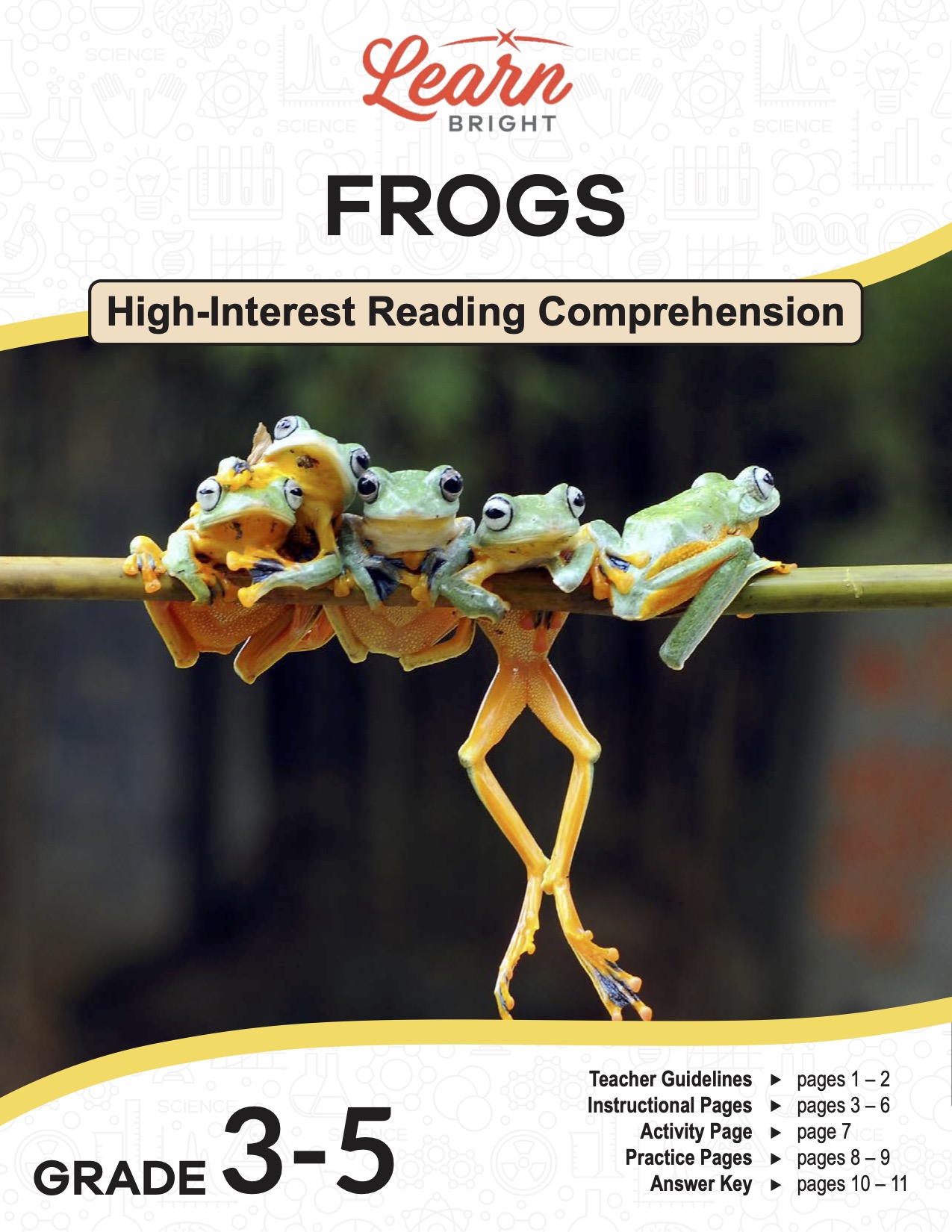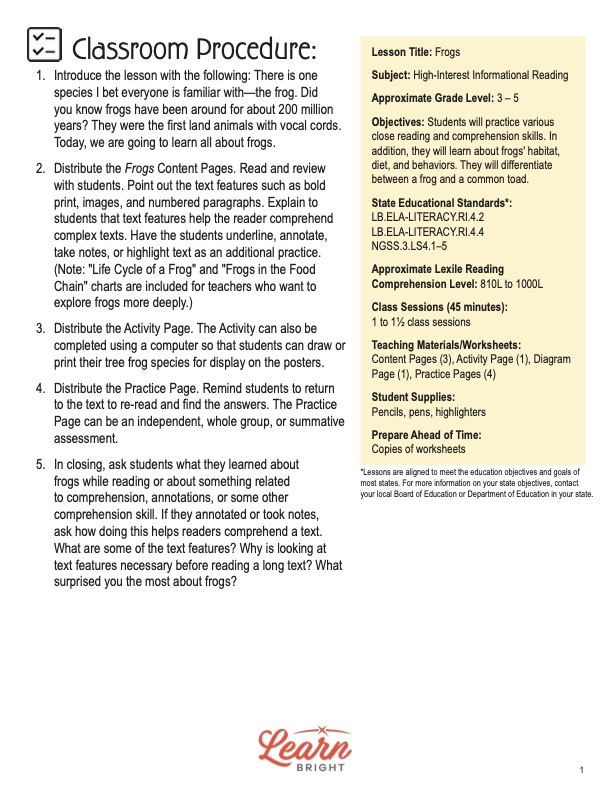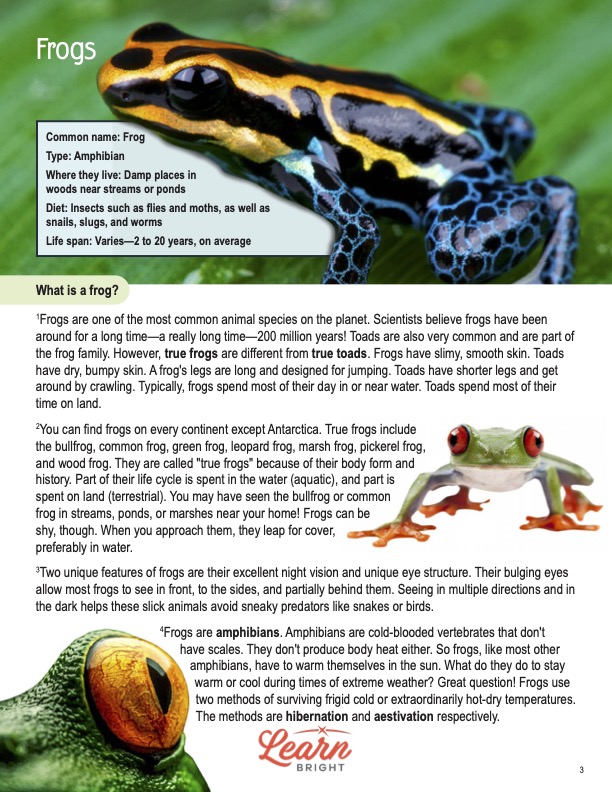Description
What our Frogs lesson plan includes
Lesson Objectives and Overview: Frogs is a high-interest reading comprehension lesson plan. As such, students will practice various close reading and comprehension skills. In addition, they will learn about the habitat, diet, and behaviors of frogs. This lesson is for students in 3rd grade, 4th grade, and 5th grade.
Classroom Procedure
Every lesson plan provides you with a classroom procedure page that outlines a step-by-step guide to follow. You do not have to follow the guide exactly. The guide helps you organize the lesson and details when to hand out worksheets. It also lists information in the yellow box that you might find useful. You will find the lesson objectives, state standards, and number of class sessions the lesson should take to complete in this area. In addition, it describes the supplies you will need as well as what and how you need to prepare beforehand. The activity in this lesson will require markers and poster board or construction paper.
Teacher Notes
The teacher notes page provides an extra paragraph of information to help guide the lesson and remind you what to focus on. It explains that you can teach this lesson in a whole-class setting or as an independent, small-group activity. The blank lines on this page are available for you to write out thoughts and ideas you have as you prepare the lesson.
FROGS LESSON PLAN CONTENT PAGES
What Is a Frog?
The Frogs lesson plan contains three content pages. To start off, it provides a small box with basic background information about frogs. Frogs are amphibians that enjoy living in damp places in woods near streams or ponds. Their diet includes insects, such as flies and moths, as well as snails, slugs, and worms. A frog’s life span varies based on various factors. But on average, they live between 2 and 20 years.
Frogs are one of the most common animal species on the planet. Scientists believe frogs have been around for a long time—a really long time—200 million years! Toads are also very common and are part of the frog family. However, true frogs are different from true toads. Frogs have slimy, smooth skin. Toads have dry, bumpy skin. A frog’s legs are long and designed for jumping. Toads have shorter legs and get around by crawling. Typically, frogs spend most of their day in or near water. Toads spend most of their time on land.
True Frogs
You can find frogs on every continent except Antarctica. True frogs include the bullfrog, common frog, green frog, leopard frog, marsh frog, pickerel frog, and wood frog. They are called “true frogs” because of their body form and history. Part of their life cycle is spent in the water (aquatic), and part is spent on land (terrestrial). You may have seen the bullfrog or common frog in streams, ponds, or marshes near your home! Frogs can be shy, though. When you approach them, they leap for cover, preferably in water.
Two unique features of frogs are their excellent night vision and unique eye structure. Their bulging eyes allow most frogs to see in front, to the sides, and partially behind them. Seeing in multiple directions and in the dark helps these slick animals avoid sneaky predators like snakes or birds.
Frogs are amphibians. Amphibians are cold-blooded vertebrates that don’t have scales. They don’t produce body heat either. So frogs, like most other amphibians, have to warm themselves in the sun. What do they do to stay warm or cool during times of extreme weather? Great question! Frogs use two methods of surviving frigid cold or extraordinarily hot-dry temperatures. The methods are hibernation and aestivation respectively.
Hibernation and Aestivation
When a frog wants to hibernate, it first finds a place to burrow into. Some frogs burrow in the mud beside the water while others make winter beds at the bottom of ponds. (And some can even freeze into frogsicles and hop away after they thaw when warmer weather returns!) Once they have a home, an amazing thing happens. The frog’s metabolism slows down so that they use less energy.
Metabolism is the process of changing foods into energy to fuel body functions. A simple way to think of metabolism is to think about a car. A car needs gas (energy) to move. The faster and longer a person drives, the more energy or gas the car burns. All animals need energy to survive. But when it’s cold, frogs slow their metabolism so much that they hardly use any of the energy stored in their fat cells. One scientist describes hibernation as “sleeping away the winter.” Once the temperature changes and it is warmer, frogs wake up and leave the burrow to find food and reproduce.
Aestivation is the second method of surviving extreme temperatures. Frigid temperatures can harm frogs, but extreme heat and dry weather are not suitable for their health either! When the weather is extremely dry and hot for an extended period, frogs burrow into soft sand. This is where aestivation differs from hibernation. During a long period of hot, dry weather, some frogs shed several layers of skin. The frog covers itself with the skin, which acts like a sunscreen blanket to keep it moist and protected from the sun’s rays. It then goes into hibernation. Only the frog’s nostrils are exposed so it can breathe! Once the rainy season starts, the frog shakes off the blankets of skin and digs out of its burrow.
Perhaps you have heard of or seen tree frogs! Tree frogs are fascinating. They have special adhesive pads and claws on their feet to help them climb. Though most are small, some species can grow nearly six inches long. Tree frogs come in various colors. Their bright coloring serves two purposes. One is to camouflage them from predators. The other, for some species, is to alert predators that the frog is poisonous. Similarly, dart frogs also have very vibrant coloring, and some species are poisonous as well. In fact, the poison dart frog produces enough toxins to be deadly to humans. It is considered one of Earth’s most toxic, or poisonous, animals.
Diet of a Frog and Other Interesting Facts
Frogs are carnivores. They dine on insects, small slugs, snails, and other aquatic species. They swallow their prey whole. If you saw a frog capture a large insect, you might see the insect squirming in the frog’s belly! Once the frog has swallowed its prey, the digestive juices in its stomach take over. Here is an interesting fact: When a frog swallows food, it pulls its eyes down into the roof of its mouth to help push the food down its throat. Here’s another interesting fact. Frogs don’t drink water through their mouths. They absorb it through their skin!
Some frogs shed their skin about once a week. After they shed their skin, they eat it! A group of frogs are called an army. A frog species found in Indonesia doesn’t have lungs. It breathes entirely through its skin. While most frogs are not particularly large, one species (goliath frog) can measure up to a foot in length and weigh nearly 10 pounds. There is a frog known as the glass frog because its skin is transparent, and you can see its internal organs! You can hear bullfrogs croaking from nearly a mile away. Those are just a few interesting facts about frogs!
Why Frogs Are Important
There are several reasons why frogs are essential to the environment. Frogs eat disease-carrying mosquitoes and are a vital food source for hundreds of animal species. Tadpoles feed on algae, which keeps streams and ponds clear. And frogs are known as bioindicators. Bioindicators are sources that indicate how healthy an ecosystem is. Remember that frogs absorb water through their skin; toxins such as pollution from factories come with the water. Scientists can measure how much of a toxin a frog absorbs and estimate how unhealthy the water is. Healthy frogs are one indicator of a healthy biosystem. Scientists also use frogs in medical research.
Unfortunately, many frog species are disappearing around the world. Loss of habitat is the biggest threat to their populations, but diseases have also had a negative impact. While many species thrive, others continue to decline or even become extinct. In fact, scientists think as many as 200 frog species are extinct, with many more endangered. Ongoing conservation efforts are working, but many species remain under stress.
Frogs Lesson Plan Diagram Page
If you’d like to dig a little deeper into the life of a frog, there are two diagrams on this page. One describes a frog’s place in the food chain. They are considered secondary consumers because they eat insects and are prey to other animals. The second diagram shows the life cycle of a frog in several stages.
FROGS LESSON PLAN WORKSHEETS
The Frogs lesson plan includes two worksheets: an activity worksheet and a practice worksheet. Each one will help students solidify their grasp of the material they learned throughout the lesson. You can refer to the classroom procedure guidelines to know when to hand out each worksheet.
FROG POSTER ACTIVITY WORKSHEET
For the activity, students will research a species of frog and color the template accordingly. Then they will use the questions at the bottom of the worksheet to create a report about what they learned. You can have students share their posters and reports with the class.
REVIEW PRACTICE WORKSHEET
The practice worksheet requires students to answer a series of 10 questions. These questions all relate to the content pages, so students will need to refer to them often for the answers. In addition, each question provides which reading tool the question corresponds to, such as text feature, vocabulary, or comprehension.
Worksheet Answer Keys
At the end of the lesson plan document is an answer key for the practice worksheet. The correct answers are all in red to make it easier for you to compare them with students’ responses. If you choose to administer the lesson pages to your students via PDF, you will need to save a new file that omits these pages. Otherwise, you can simply print out the applicable pages and keep these as reference for yourself when grading assignments.










